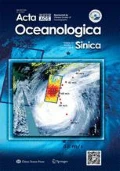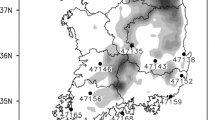Abstract
This study revealed a high positive correlation between rainfall in Korea during September and the trade wind (TW)/Arctic Oscillation (AO) index in May that combines two climate factors, low-level TWs and the AO. This correlation was identified on the basis of the difference in the 850 h Pa streamline analysis between the positive and negative phases selected using the combined TW/AO index. In May, the spatial pattern of the anomalous pressure systems is similar to that in the positive AO phase. These anomalous pressure systems continue in June to August (JJA) and September, but the overall spatial distribution shifts a little to the south. Particularly in September, a huge anomalous anticyclone centered over the southeast seas of Japan strengthens inmost of the western north Pacific region and supplies a large volume of warm and humid air to the region near Korea. This characteristic is confirmed by the facts that during the positive TW/AO phase, the subtropical western north Pacific high (SWNPH) is more developed to the north and that the continuous positioning of the upper troposphere jet over Korea from May to September strengthens the anomalous upward flow, bringing warm and humid air to all layers. These factors contribute to increasing September rainfall in Korea during the positive TW/AO phase. Because the SWNPH develops more to the north in the positive phase, tropical cyclones tend to make landfall in Korea frequently, which also plays a positive role in increasing September rainfall in Korea. The above features are also reflected by the differences in average rainfall between the six years that had the highest May Niño 3.4 indices (El Niño phase) and the six years that had the lowest May Niño 3.4 indices (La Niña phase).
Similar content being viewed by others
References
Byun H R, Lee D K. 2002. Defining three rainy seasons and hydrological summer monsoon in Korea using available water resources index. JMeteor Soc Japan, 80(1): 33–44
Choi Y J. 2004. Trends on temperature and precipitation extreme events in Korea. J Korean Geogr Soc (in Korean), 39: 711–721
Choi K S, Kim B J. 2007. Climatological characteristics of tropical cyclones making landfall over the Korean Peninsula. Asia-Pacific J Atmos Sci, 43(2): 97–109
Choi Y J, Moon J Y. 2000. Observed trends in the daily precipitation intensity of Korea summer season. Atmosphere (in Korean), 10: 339–341
Choi K S, Moon J Y, Kim D W, et al. 2010. The significant increase of summer rainfall occurring in Korea from 1998. Theor Appl Climatol, 102(3): 275–286
Choi K S, Oh S B, Byun H R, et al. 2011. Possible linkage between East Asian summer drought and North Pacific Oscillation. Theor Appl Climatol, 103(1): 81–93
Choi K S, Wang B, Kim D W. 2012. Changma onset definition in Korea using the available water resources index and its relation to the Antarctic Oscillation. Clim Dyn, 38: 547–562
Chung Y S, Yoon M B. 2000. Interpretation of recent temperature and precipitation trends observed in Korea. Theor Appl Climatol, 67(3): 171–180
Chung Y S, Yoon M B, Kim H S. 2004. On climate variations and changes observed in South Korea. Clim Change, 66(1): 151–161
Gong D Y, Ho C H. 2003. Arctic oscillation signals in the East Asian summer monsoon. J Geophys Res, 108(D2): 4066, doi:10.1029/2002JD002193
Ha K J, Park S K, Kim K Y. 2005. On interannual characteristics of climate prediction center merged analysis precipitation over the Korean Peninsula during the summer monsoon season. Int J Climatol, 25: 99–116
Ha K J, Park S K, Lim K Y. 2003. Interannual variability in summer precipitation around the Korean Peninsula and its associated East Asian summer circulation. Asia-Pacific J Atmos Sci, 39(5): 575–586
Ha K J, Yun K S, Jhun J G, et al. Circulation changes associated with the interdecadal shift of Korean August rainfall around late 1960s. J Geophys Res, 114: D04115, doi:10.1029/2008JD011287
Ho C H, Lee J Y, Ahn M H, et al. 2003. A sudden change in summer rainfall characteristics in Korea during the late 1970s. Int J Climatol, 23(1): 117–128
Hong S G. 1999. A study on the threshold values of heavy rain waning in Korea. Asia-Pacific J Atmos Sci (in Korean), 35: 178–192
Ju J H, Lu J M, Cao J, et al. 2005. Possible impacts of the arctic oscillation on the interdecadal variation of summer monsoon rainfall in East Asia. Adv Atmos Sci, 22(1): 39–48
Kalnay E, Kanamitsu M, Kistler R, et al. 1996. The NCEP/NCAR 40-year reanalysis project. Bull AmMet Soc, 77(3): 437–471
Kistler R, Kalnay E, Collins W, et al. 2001. The NCEP-NCAR 50-year reanalysis: monthly means CD-ROM and documentation. Bull AmMet Soc, 82(2): 247–267
Ko J W, Baek H J, Kwon W T. 2005. The characteristics of precipitation and regionalization during rainy season in Korea. Asia-Pacific J Atmos Sci (in Korean), 41(1): 101–114
Lau N C, Nath M J. 2000. Impact of ENSO on the variability of the Asian-Australian monsoons as simulated in GCM experiments. J Clim, 13(24): 4287–4309
Liang X Z, Wang W C. 1998. Association between China monsoon rainfall and tropospheric jets. Quart J Roy Meteor Soc, 124(6): 2597–2623
Liebmann B, Smith C A. 1996. Description of a complete (interpolated) outgoing longwave radiation dataset. Bull Am Met Soc, 77(6): 1275–1277
Park J K, KimB S, Jung WS, et al. 2006. Change in statistical characteristics of typhoon affecting the Korean Peninsula. Atmosphere (in Korean), 16(1): 1–17
Thompson D W J, Wallace J M. 1998. The arctic oscillation signature in the wintertime geopotential height and temperature fields. Geophy Res Lett, 25(9): 1297–1300
Thompson D W J, Wallace J M. 2000. Annularmodes in the extratropical circulation: Part I. Month-to-month variability. J Clim, 13: 1000–1016
Wilks D S. 1995. Statisticalmethods in the Atmospheric Sciences. San Diego, CA, USA: Academic Press, 467
Yun W T, Park C K, Lee J W, et al. 2001. Analysis of the Korean heavy rainfall features in summer 1998. Asia-Pacific J Atmos Sci, 37(2): 181–194
Author information
Authors and Affiliations
Corresponding author
Additional information
Foundation item: A grant from“Development of Meteorolocial Resources for Green Growth” and “Research for the Meteorological and Earthquake Observation Technology and Its Application” supported by the NIMR/KMA under contract No.NIMR-2012-B-3 and the Korea Research Foundation Grant funded by the Korean Government (MOEHRD, Basic Research Promotion Fund) under contract No. KRF-2007-331-C00255.
Rights and permissions
About this article
Cite this article
Choi, KS., Moon, IJ. Two climate factors in May that affect Korean rainfall in September. Acta Oceanol. Sin. 32, 32–47 (2013). https://doi.org/10.1007/s13131-013-0265-9
Received:
Accepted:
Published:
Issue Date:
DOI: https://doi.org/10.1007/s13131-013-0265-9




